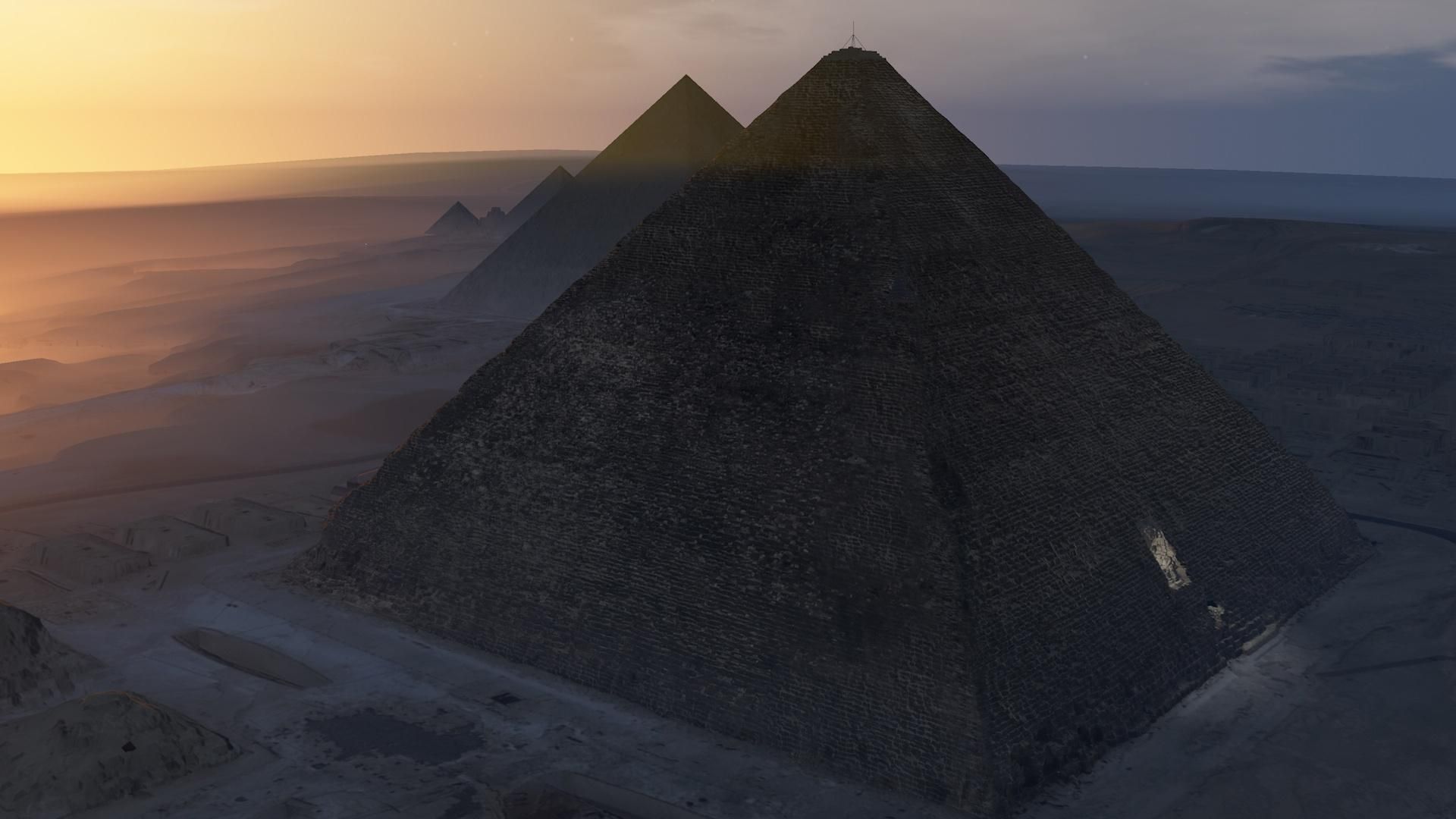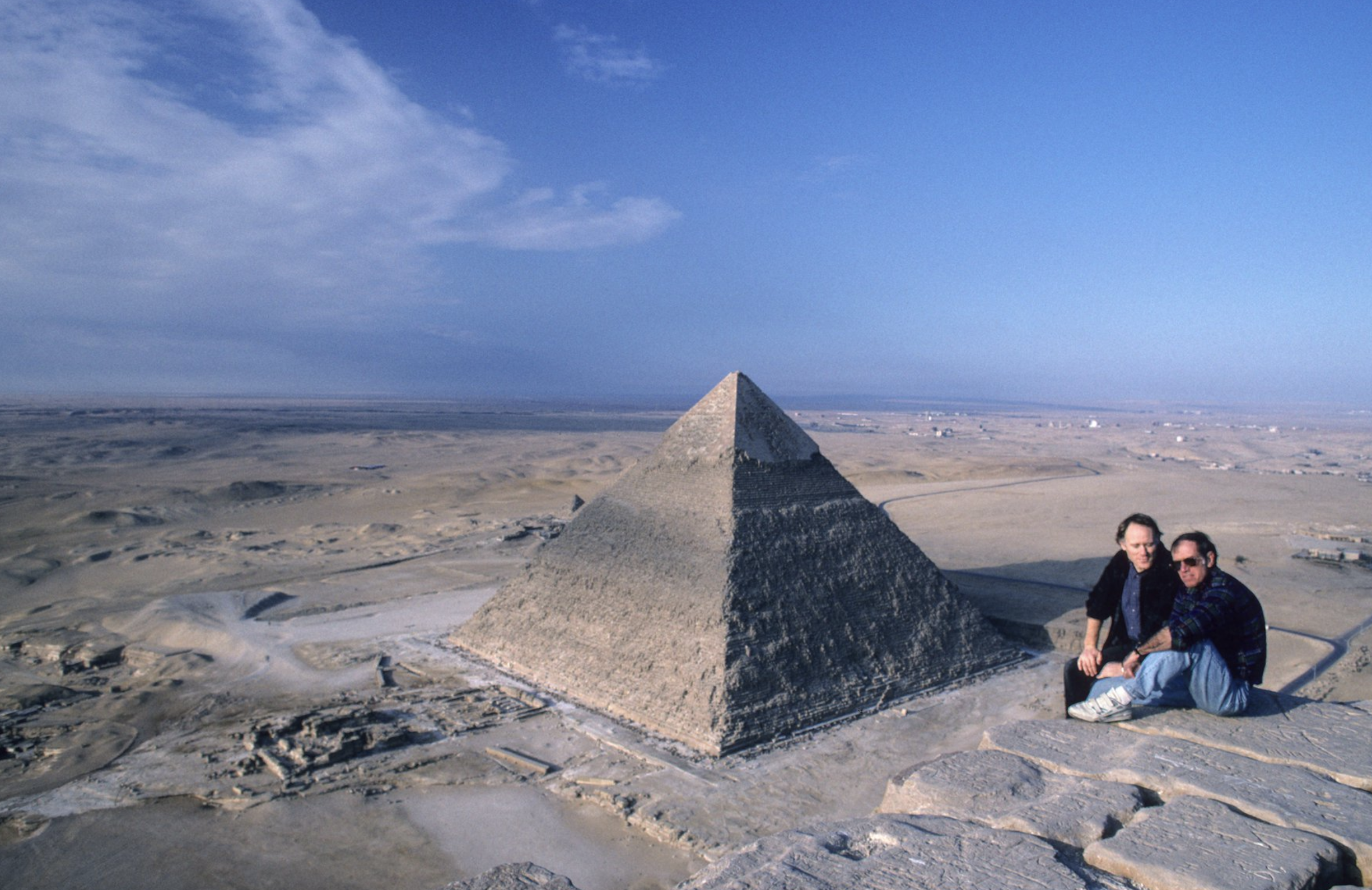Who built the Pyramids: Aliens, Ancient Civilizations, Egyptians
The pyramids of Egypt fueled debate for centuries over how such massive monuments could have been constructed thousands of years ago without modern machinery, leading some to conjecture that ancient Egyptians had external help from extraterrestrials or a now-lost civilization.

I'm 38 lectures deep into the history of Egypt. This is a work in progress, collecting my research as I go. You've been warned...
How did the pyramids show up
Who built the pyramids? I mean, who really built the pyramids?
Aliens, an advanced ancient civilization, or the ancient Egyptians themselves? This question has puzzled historians and captured public fascination for centuries. The magnitude of the pyramids inspires awe and incredulity that mere humans could achieve such a feat thousands of years ago without modern technology.
The pyramids contain around 2.3 million stone blocks, some weighing up to 80 tons. The Great Pyramid of Giza towers 481 feet tall, and its base covers an area greater than 13 acres. Constructing such enormous monuments required tremendous organization, resources, and manpower.

Yet archaeological evidence indicates humans inhabited the Nile region for hundreds of thousands of years before the pyramids were built.
Could the ancient Egyptians be responsible, or is there more to the story? The debate continues today. Just check out the JRE or History Channel for proof.
Some contend extraterrestrials or a now-extinct advanced civilization aided the pyramid builders. However, most Egyptologists attribute the pyramids solely to the ingenuity and effort of ancient Egyptians during the Old Kingdom period.
While mysteries remain, each new archaeological find adds to our understanding of ancient Egyptian civilization. The quest to unravel the origins of the pyramids captivates us because knowing our past enriches our perspective of humanity's vast potential.
Methods of Construction
The staggering scale and geometric precision of the pyramids make some skeptical that humans alone could achieve such feats thousands of years ago. This has fueled imaginative theories of extraterrestrial or advanced civilization involvement.
Extraterrestrial intervention hypothesis
The extraterrestrial intervention hypothesis contends that alien beings assisted in the construction of the pyramids or built them directly as part of some larger intergalactic project on Earth. Supporters of this theory point to several factors that suggest advanced knowledge beyond the capabilities of ancient humans.

First, the enormous blocks were cut, moved, and positioned with tremendous precision, perfectly aligned and tightly fitted together. Some of the granite blocks used in the Great Pyramid's interior weigh up to 80 tons. It boggles the mind to imagine moving such massive stones without modern machinery. Advocates argue that this requires technology and knowledge far surpassing what archaeology attributes to the ancient Egyptians.
Second, the alignment and dimensions of the pyramids contain encoded astronomical features. The pyramid shafts point precisely to certain stars and constellations as they appeared in 2500 BC when the pyramids were built. The pyramids are also carefully oriented to the cardinal directions - north, south, east, and west - with slight deviations likely due to Earth's precession. This advanced astronomical and geometric sophistication seems improbable without outside help.

Finally, adherents point to the lack of any definitive accounts of construction techniques in the historical record. No ancient Egyptian texts clearly explain how they accomplished these feats of engineering. This missing knowledge opens the door for those who believe humans alone could not have designed and built such monumental structures.
While intriguing, no direct evidence verifies extraterrestrial involvement. However, in the absence of proven methods, some find the alien hypothesis more compelling than the mainstream view crediting the ancient Egyptians themselves.
Silurian hypothesis: lost advanced civilization
Some theorize that an as yet undiscovered advanced civilization developed sophisticated pyramid building techniques, which were later taught to the ancient Egyptians who then constructed the pyramids. This hypothetical precursor civilization possessed engineering capabilities and mathematical knowledge far beyond what is attributed to ancient peoples.

Proponents of this idea point to the staggering complexity and scale of pyramid construction as evidence of lost knowledge. They argue that absent a full understanding of this alleged forgotten science, we cannot appreciate how these monumental structures were erected thousands of years ago.
According to this view, this lost civilization developed innovative techniques for moving and positioning massive blocks with precision. They had a deep grasp of geometry, astronomy, and other sciences integrated into the pyramids' design. This sacred knowledge was passed down and preserved over generations only to be lost to history later.
However, the systematic excavation and study of pyramid sites has not yielded any direct clues to support the existence of such an advanced precursor civilization. No artifacts or records from such a culture have been found. Nevertheless, believers maintain there could be discoveries still awaiting unearthing by future archaeologists.
While the evidence is lacking, some find the notion of an even more distant progenitor civilization more plausible than the ancient Egyptians building the pyramids themselves. The desire to imagine a greater forgotten past persists and fuels this alternative theory.
Graham Hancock and the pyramids
Alternative theorist Graham Hancock has popularized fringe notions of an unknown advanced civilization predating Ancient Egypt that bequeathed pyramid knowledge. However, Hancock's claims lack substantive evidence and contradict archaeological consensus.

Hancock points to the alignment of Giza pyramids with Orion's Belt as an encoded astronomical map intentionally created 12,500 years ago. However, no evidence places monumental construction that far back, and alignments can arise by coincidence.
He also argues similarities between Aztec and Egyptian pyramids demonstrate lost transoceanic influence. However, stepped pyramids are intuitive shapes worldwide. Pyramids in Mesoamerica likely arose independently rather than by diffusion.
Mainstream archaeology has firmly refuted Hancock's conjectures as exaggerations, misinterpretations and imaginations unsupported by artifacts or data. There are enough genuine mysteries about Ancient Egypt without needing fabrication. The desire for hidden complexity must not override evidence or reason.
While intriguing, claims of unknown precursor civilizations represent pseudoarchaeology until verified by the archaeological record. We must ground our understanding of human accomplishment in facts, not fanciful conjectures. The ancients were ingenious enough without invented mythology.
Debunking Hancock
While imaginative, Graham Hancock's conjectures about a lost global seafaring civilization from over 12,000 years ago contradict extensive archaeological evidence on multiple fronts.

- Archeological Evidence
There is a total absence of expected material evidence for such a civilization, including widespread ruins of cities, infrastructure for advanced metalworking, and remnants of complex tools or engineering. Instead, evidence points to primitive Stone Age cultures before the proposed Younger Dryas period.
We would expect to find settlements inland along major river systems if the civilization spanned continents, but archaeology reveals no such sites. - Genetic Evidence
There is no evidence either of shared agriculture or crop domestication across continents before the Younger Dryas, as Hancock claims. A globe-spanning civilization would also have left definitive genetic traces through interbreeding not seen in studies. Genetic studies of Native Americans, Aboriginal Australians, and Pacific Islanders indicate long prehistoric isolation contradicting Hancock's assertions. Additionally, agricultural data show geographic isolation of crops like corn, rice, and wheat until modern times.

In 2018, 92 scientists published the best-known research tracing genetic trait formation across geography and time. You can read the entire paper here.
Challenges in deciphering construction methodologies
While mainstream archaeology attributes the pyramids to the ancient Egyptians, some cast doubt by pointing to the lack of complete and definitive documentation of how the monumental structures were constructed. No ancient Egyptian texts clearly outline techniques for moving and positioning massive stone blocks with such eye-watering precision.

Some argue that without full insight into the engineering feats involved, we cannot be certain the ancient Egyptians acted alone without outside help. They contend that absent a complete methodological scheme, the pyramids remain inscrutable mysteries.
However, archaeologists have pieced together a basic understanding of construction techniques based on tools found at sites, artistic representations, and other clues. Ramps, levers, ropes, and brute human strength were likely employed in building the pyramids. But many details remain hazy.
For example, one enduring question is exactly how the heavy blocks were transported many miles overland from distant quarries. No ancient papyri or inscriptions describe the logistics in full. Similarly, while likely used in some form, the configuration and size of ramps is still partially guesswork.
Also, some finer points of architectural elements seem improbably sophisticated even with clearest construction theories. This includes the remarkably precise alignments and dimensions encoded in the structures.
The full picture remains incomplete. However, archaeologists contend the major gaps and question marks are not enough to seriously propose advanced external construction by aliens or lost civilizations. But doubts linger for some, fueled by the limited historical record of how these awe-inspiring monuments were crafted.
Of course, the simplest explanation is often the right one. The ancient Egyptians developed remarkable innovations in engineering and organization to achieve these constructions. However, some find it more stimulating to imagine a greater hidden story behind the pyramids. Our limited records of ancient times allow such theories to persist.
Human Habitation in Egypt Over the Past Million Years
Archaeological evidence shows humans inhabited Egypt for hundreds of thousands of years before the pyramids were built. This supports the view that ancient Egyptians developed the knowledge and skills in engineering, organization, and agriculture necessary to construct the pyramids themselves.
Early human existence in Egypt
Archaeological discoveries in Egypt reveal traces of human activity dating back over 2 million years, providing evidence of an enduring human presence since deep prehistory.
Discovery of 2 million-year-old stone tools
In the 1960s, archaeologists uncovered primitive Oldowan stone tools over 2 million years old in archaeological sites near Kom Ombo, Egypt. Additional sites containing hundreds of thousands of similar stone tools have also been found throughout Egypt. These crude choppers and flakes date to the early Pleistocene era, indicating humans or human predecessors inhabited the Nile region extremely early on.

Unearthing of the oldest human footprint
In 2017, researchers discovered footprints embedded in fossilized mudflats in the area of what is now Ain Sukhna, Egypt. Analysis dated these prints to over 2 million years ago, representing the oldest known human footprint. Over 400 early human footprints were uncovered, likely rapidly buried by falling ash from a volcano eruption. This remarkable find offers a snapshot of early humans thriving along the ancient Nile.

Discovery of 800,000-year-old artifacts
In addition to stone tools, other sophisticated artifacts have been uncovered in Egypt dating back hundreds of thousands of years, providing further evidence of advanced human behavior predating civilizational eras.
In the site of Ain Hanech in modern day Algeria, archaeologists excavated crude but shaped stone choppers dating to 1.8 million years ago, indicating possible early experimentation with stone flaking techniques that later became ubiquitous.
At a prehistoric site in Dar es-Soltan I near Rabat, Morocco, a team unearthed Aterian stone tools, charred animal bones, shell beads for jewelry, and pigment usage dating back roughly 150,000-200,000 years. Humans were clearly thriving in North Africa during this era.
Most remarkably, archaeologists discovered ceramic fragments, including pieces of an ancient clay pot, estimated to be approximately 800,000 years old near present-day Cairo. If dating bears out, this find would pre-date the advent of pottery by hundreds of thousands of years, forcing a re-evaluation of the origin of this technology.

Taken together, these discoveries paint a picture of innovation and advanced human behavior in the Nile region spanning back nearly a million years before the pyramids were conceived.
These discoveries provide definitive evidence of early humans straying beyond the Rift Valley where our ancestors first developed. While limited, these finds suggest early bands of humans were drawn to and populated the Nile's hospitable shores over 2 million years ago. This deep history sets the stage for the agricultural villages and civilizations to later emerge in Egypt.
Prehistoric Egypt
The lengthy human presence in Egypt reached new levels of sophistication during the Neolithic period starting around 6000 BC. During this prehistoric era, permanent settlements appeared along the Nile River Valley, laying the agricultural foundations necessary to enable large-scale construction projects like the pyramids in the future.
Neolithic settlements circa 6000 BC
Whereas Paleolithic humans were nomadic hunter-gatherers, Neolithic Egyptians began establishing semi-permanent mudbrick dwellings, especially in the fertile Nile Delta region. Small villages appeared with communal granaries to store surplus crops, marking a transition toward organized agriculture.
Archaeologists have uncovered relics of these early habitual settlements, containing seeds of indigenous emmer wheat, barley and flax grown in the Nile Valley as early as 6000 BC. Rudimentary farming had emerged.
Emergence of agriculture and permanent settlements
As the climate grew hotter and dryer toward the end of the Neolithic Subpluvial period, people congregated more densely around the reliable Nile River floodplain. This spurred the development of sophisticated irrigation systems to control and harness the river's seasonal inundation.
Reliable agriculture allowed early Egyptians to inhabit permanent settlements and support population growth. Domesticated livestock including pigs, cattle, sheep and goats were raised. Pottery and woven baskets appeared. Lakeshore dwellings gave rise to fishing. This meat and grain surplus enabled civilization-scale habitation.
Ancient Egyptian civilization
The long arc of human advancement in Egypt reached its apex with the emergence of one of humanity's first great civilizations along the Nile River Valley. This set the stage for innovations in architecture, agriculture, and sociopolitical organization that enabled the construction of the pyramids.
Inception of Pharaonic civilization around 3100 BCE
After centuries of Neolithic farming settlements, the first territorial state emerged around 3100 BCE under King Narmer, marking the beginning of Ancient Egypt and the Pharaonic era. This signified a major leap in social stratification, central administration, and capability to mobilize labor for state projects.

Artifacts like the Narmer Palette depict early Egyptian writing for record-keeping and governance. Cities with monumental architecture like Memphis became administrative hubs and visible symbols of centralized power. This societal complexity was a prerequisite for designing and building monumental pyramids.
Pyramid construction period from 2630 to 1525 BCE
The pinnacle of ancient Egyptian civilization was the Old Kingdom period from around 2630 BCE to 2180 BCE when pyramid construction flourished. The Third Dynasty ruler Djoser commissioned the first Step Pyramid at Saqqara. Subsequent pyramids grew larger and more sophisticated, culminating in the Great Pyramid of Giza built for Pharaoh Khufu in the Fourth Dynasty.
This era saw innovations in architecture, math, engineering, and agriculture to enable these accomplishments. For example, the Egyptians developed a 365-day calendar to better predict Nile flooding patterns to provision pyramid workers. This flowering of civilization dispels notions that pyramids appeared abruptly without relevant precursor advancements on the Nile.
This long developmental arc on the Nile contradicts notions of pyramids springing suddenly into existence without relevant foundations in local knowledge and population growth. The ancient Egyptians left clear cultural and material continuity illuminating their accomplishments.
Egyptians as the Pyramid Builders
While some doubt ancient Egyptians could achieve such marvels alone, most evidence indicates they developed the necessary knowledge, organization, and construction techniques to build the pyramids through ingenuity and labor over many generations.
A history of building
The ancient Egyptians developed architectural know-how through generations of experimenting with simpler structures before achieving the precision and grandeur of the pyramids. This evolutionary trajectory contradicts notions of pyramids appearing suddenly without relevant precursors.

The pyramid form is an intuitive shape for stacking stones that does not require complex math or engineering skill. Before the first Step Pyramid, Egyptians constructed rectangular Mastaba tombs for elite burials. The progression from Mastaba to Step Pyramid shows experimentation with larger stone buildings over time.

Even earlier, Sumerians in Mesopotamia built Ziggurats - massive stepped platforms topping smaller pyramids. The Ziggurat of Ur dates back 4,000 years before the Giza pyramids. The ancient world was already grappling with monumental stacked architecture millennia before Egypt perfected the classic pyramid.

This cultural continuity reveals an incremental mastery of stone masonry and engineering over generations, not a sudden leap in sophistication without precedent. The pyramids were the apotheosis of this experiential learning curve, not an anomalous anomaly requiring external intervention.
Archaeological proof of construction techniques
Mainstream archaeology has pieced together a basic understanding of how the ancient Egyptians constructed the pyramids using various tools, artwork, and other clues discovered through excavation. This provides evidence the monumental structures were built by human hands employing ingenuity, organization, and brute labor power over generations.
Ramps of mud brick and rubble were likely constructed to drag the blocks into position. Remnants of ancient ramps have been found at some sites. Reliefs and artwork depict teams of laborers pulling a stone block up a ramp using ropes. Log rollers placed under the sleds helped ease movement.
Levers were inserted into slots within the blocks to tilt them incrementally into place. Markings of such lifting points are visible on pyramid blocks along with abrasion scars indicating movement. Archaeologists have uncovered wooden levers nearby.
The ancient Egyptians possessed rope, chisels, saws and other copper tools to cut and manipulate the massive stones with precision. Rope fragments have been found in tombs, and experiments show wet fiber ropes can move multi-ton loads. This demonstrates ancient feasibility.
While some finer details like the size and location of ramps are still unknown, Egyptologists contend this evidence confirms the pyramids were built by the Egyptians' own ingenuity, organization, and labor, not impossible without external aid.
Evolution of civil service and organization
In the centuries leading up to major pyramid construction, ancient Egyptian society developed advanced systems of administration, agriculture and civil service to organize and provision the large workforces needed for monumental projects.
Archaeological evidence shows the early Egyptian state was distributing rations to workers as far back as 3500 BCE. Government bakeries, granaries and warehouses stored food. Tags found in tombs record workers receiving payment in bread, beer and other provisions.
This establishment of a bureaucracy to track supplies and compensated labor on a grand scale demonstrates substantial organization even pre-dating the pyramids.
Later, for major pyramid construction, the workforce for a single pyramid could swell to tens of thousands during harvest off-seasons. Overseers managed rotating labor teams with specialized roles like hauling, lifting, and fitting stones. Scribes tracked worker attendance and compensation. The Egyptians' own civil service infrastructure enabled this mobilization.
Agricultural productivity also dramatically expanded through irrigation systems, sowing schedules timed with Nile flooding, and optimized crop selection to feed the pyramid builders. Egyptians generated a enormous labor force and agricultural surplus themselves.
The original blue collar job
The hundreds of thousands of laborers who constructed the pyramids demonstrate that monumental human-made wonders do not require mystery, just organization and effort.
Ancient Egypt did not rely on slaves to build the pyramids, but paid workers. During the agricultural off-season when the Nile flooded, farmers were redeployed in labor teams supervised by foremen. Some were permanent specialists like stone cutters.
Workers received payment in rations of bread, beer, and other provisions. Though difficult and dangerous, pyramid construction employed thousands for decades and supported entire ancillary industries.
This father-to-son occupation revealed in the historical record contradicts exotic notions of extraterrestrials swooping in to erect pyramids. Instead, generations of ordinary Egyptians incorporated innovations in architecture, math, and engineering to achieve a feat of human coordination still unmatched today.
The pyramids testify to humanity's immense potential through organized society - no mystery required. The ancient Egyptians stand as prototypes of a prosperous middle class sustained by their monumental industry and innovation.
Absence of substantial evidence for alternative theories
While intriguing, theories of lost civilizations or extraterrestrial construction lack direct archaeological evidence that should exist if such claims were valid. No anomalous artifacts or records documenting advanced or alien knowledge have been discovered at Giza or other pyramid sites.
Supporters of these alternative explanations argue evidence may yet be found for precursor civilizations or alien intervention. However, extraordinary claims require extraordinary proof. Assertions not backed by artifacts and documentation verge on myth and pseudohistory.
Certainly, there are gaps in our full understanding of how the pyramids were engineered. However, the absence of complete records is hardly evidence of secret lost or alien knowledge. It simply reflects the limited written history from 4,500+ years ago.
Nonetheless, fringe theories persist in claiming the mainstream ignorance around pyramid construction details points to hidden realities. This results from psychological tendencies to prefer exotic explanations over mundane realities and discomfort with ambiguities in knowledge.
While complete certainty is elusive, the simplest interpretation aligning with existing evidence is that ancient Egyptians combined ingenuity, organization, and intense labor over generations to construct the pyramids themselves, without external aid.
Conclusion
The origins of the Egyptian pyramids remain mysterious enough to fuel continued debate, but not so unknown as to seriously doubt human capabilities. The accomplishments of the pyramid builders reveal both the ingenuity and hubris of our species.
The core enigma persists. Exactly how did ancient Egyptians construct such massive monuments with intricately fitted stones and precise celestial alignments without modern machinery? Absent records explicitly detailing methods, phantom gaps in knowledge allow fringe theories to linger.
Partly this reflects legitimate unease with attributing such sophistication to prehistoric civilizations. But mostly it stems from the human tendency toward fabulism - preferring exciting hidden narratives over mundane realities.
Some argue that absent records explicitly documenting pyramid construction methods, we cannot fully comprehend the accomplishments of ancient Egyptians. However, the loss of techniques over centuries is a common pattern across civilizations.
For example, concrete was pioneered by Romans but the formula was later forgotten during the Middle Ages, only to be rediscovered centuries later. The intricate art of Greek fire used in naval warfare has been lost to history. We can only speculate on the mechanics of ancient Greek automata like the Antikythera mechanism.
Likewise, while we do not have complete step-by-step instructions for building pyramids, archaeologists have reconstructed the basic means based on tools, artifacts, and other clues. We must not underestimate the expertise of ancient peoples just because some knowledge was later misplaced. The pyramids stand as monuments to ingenuity - even if the full methods are now faded.
Still, applying scrutiny, the evidence clearly points to ancient Egyptians themselves architecting and building the pyramids through generations of organization, agricultural surplus and trial-and-error structural refinement.
Appreciating this more grounded narrative holds profound significance for our self-perception. Glyphs carved millennia ago still proclaim "We did this!" Humanity's legacy is not just inheritance, but cumulative accomplishment.
The pyramids remind us of our species' dazzling potential - what we can achieve through cooperation and incremental progress when not self-limited by lack of imagination. This sense of wonder at our shared history must persist even if its specifics remain partly veiled in the sands of time.



